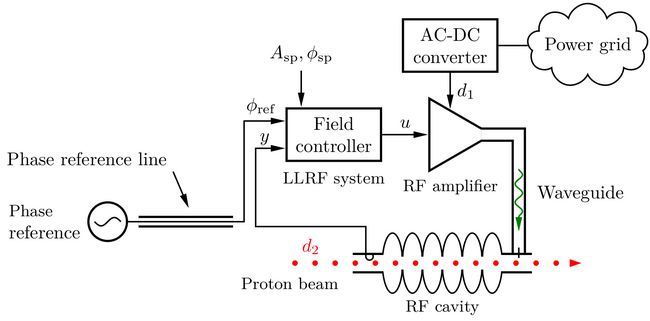Control of the European Spallation Source
Researchers:Bo Bernhardsson, Anders J Johansson (Dept. of Electrical and Information Technology), Rolf Johansson, Olof Troeng, Björn Olofsson
Funding:European Spallation Source
The European Spallation Source will, once completed, be the world’s brightest neutron source. Its long, high-intensity pulses have been said to bring a paradigm shift to neutron imaging, and will enable break-throughs in pharmacology, chemistry, solid-state physics, engineering sciences, material sciences, and archeology. Neutrons are an attractive complement to light and X-rays since they reveal otherwise invisible features. More info here.
The need of cavity field control
The protons will be accelerated by oscillating electromagnetic fields confined in metal structures called RF cavities. In total there will be 155 RF cavities of six different types along the more than 400 meters long linear accelerator. In terms of average power, the ESS accelerator will be the world's most powerful.
To properly accelerate the protons it is crucial to accurately control the amplitudes of the electromagnetic fields, as well as their phases relative to the protons. Otherwise, the protons get the wrong velocity, and get deflected into the cavity walls, causing radioactivation.
Cavity Field Control
To conrol the cavity fields, feedback loops with sampling frequencies of 10 MHz will be used. The Department of Automatic Control is involved in system modeling and controller design for the these loops, as well as supporting the requirement engineering for RF system components. The work is coordinated by this group at the Department of Electrical and Information Technology.
Our analysis of the field-control loop has been based on an equivalent complex-valued baseband representation of the system dynamics. This representation is well known, but it has not previously been used for control design. With the complex-valued representation, the cavity dynamics takes the form of a single-input single-output system, which greatly simplifies the analysis.


Temperature Control of Phase-Reference Line
In order to distribute the reference phase from the master oscillator to the beam position monitors and the 155 cavity field control loops with sufficiently small drift requires that the more than 500 meters long phase distribution line is temperature stabilized to less than a tenth of a degree.
The Dept. of Automatic Control at Lund University is involved in the design and development of the temperature control system for the phase distribution line. The research performed includes modeling and simulation of the control system as well as experimental evaluations on a prototype of the phase-reference distribution system.
Compensation of Lorenz-Force Detuning
The high strengths of the electro-magnetic fields in the super conducting cavities leads to mechanical deformation cavity wall, which changes their fundamental resonance frequency. This leads to reduced efficiency and makes the RF field control problem harder. The Department of Automatic Control will together with collaborating European universities design the control algorithm for the piezo-electric compensation system that will be used to counter-act the Lorenz force detuning. The work is coordinated by this group at the Department of Electrical and Information Technology.
Other Investigations
Simulations of Cryogenic Distribution Line at ESS
The cryogenic system at ESS has been modeled in Dymola. Simulations have been made of the cool-down and warm-up of the superconducting section of the linear accelerator. Also the required capacity of the helium safety discharge system has been investigated.
Publications
Olof Troeng, Bo Bernhardsson: "An Intuitive Design Method for Disturbance-Rejecting Peak Filters". In The 14th IEEE International Conference on Control and Automation 2018, Anchorage, Alaska, United States, June 2018.
Olof Troeng: "Cavity Field Control for High-Intensity Linear Proton Accelerators". Licentiate Thesis Department of Automatic Control, Lund University, Sweden, November 2017.
Olof Troeng, Bo Bernhardsson: "Energy Optimal Excitation of Radio-Frequency Cavity". IFAC-PapersOnLine, 50:1, pp. 10644–10648, 2017.
Olof Troeng, Bo Bernhardsson, Claudio Rivetta: "Complex-coefficient systems in control". In American Control Conference 2017, Seattle, United States, May 2017.
Björn Olofsson, Bo Bernhardsson, Rihua Zeng, Pontus Andersson: "Temperature Control of the ESS Phase Reference Line". Conference Poster. In 8th International Particle Accelerator Conference, IPAC 2017, Copenhagen, Denmark, May 2017.
Olof Troeng, Björn Olofsson, Bo Bernhardsson, Anders J Johansson, Rolf Johansson: "Control Problems at the European Spallation Source". In Reglermöte 2016, Göteborg, Sweden, June 2016.
Riccard Andersson: "Cool-down and Warm-up of the Cryogenic Distribution Line at ESS". Master's Thesis ISRN LUTFD2/TFRT--5939--SE, Department of Automatic Control, Lund University, Sweden, 2014.
Josefin Berner, Aminda Ingulfson: "Optimal Control Algorithms for Klystron Efficiency in ESS". Master's Thesis ISRN LUTFD2/TFRT--5902--SE, Department of Automatic Control, Lund University, Sweden, June 2012.
Arnbjörn Einarsson, Babak Rajabian: "Optimal Control Algorithms of Pulsed Accelerating Fields in Superconducting Spoke Cavities in ESS". Master's Thesis ISRN LUTFD2/TFRT--5905--SE, Department of Automatic Control, Lund University, Sweden, June 2012.


